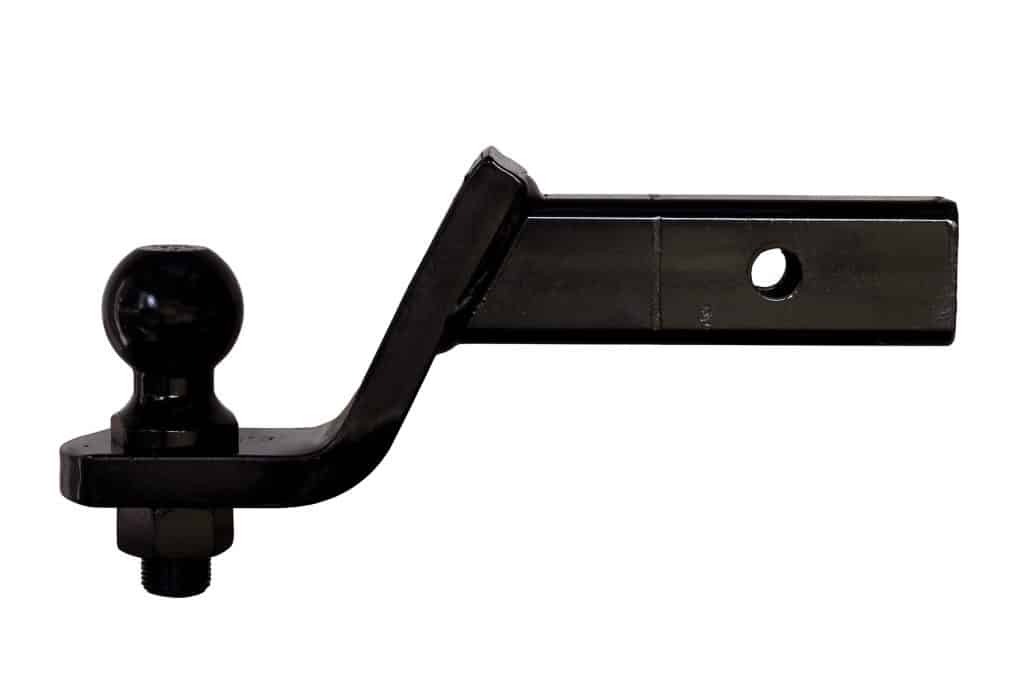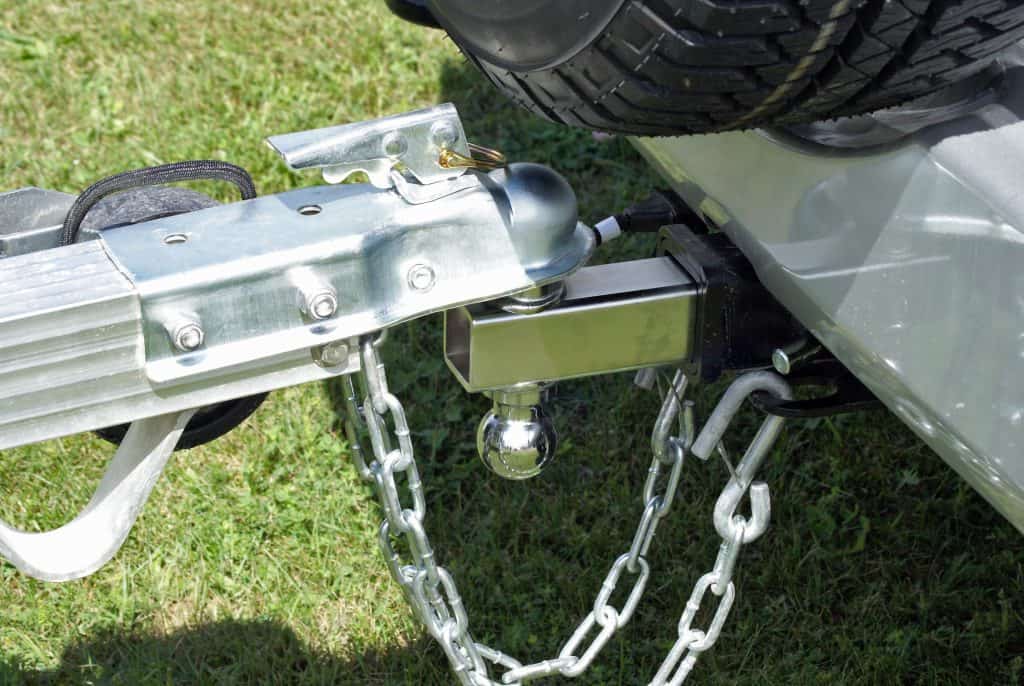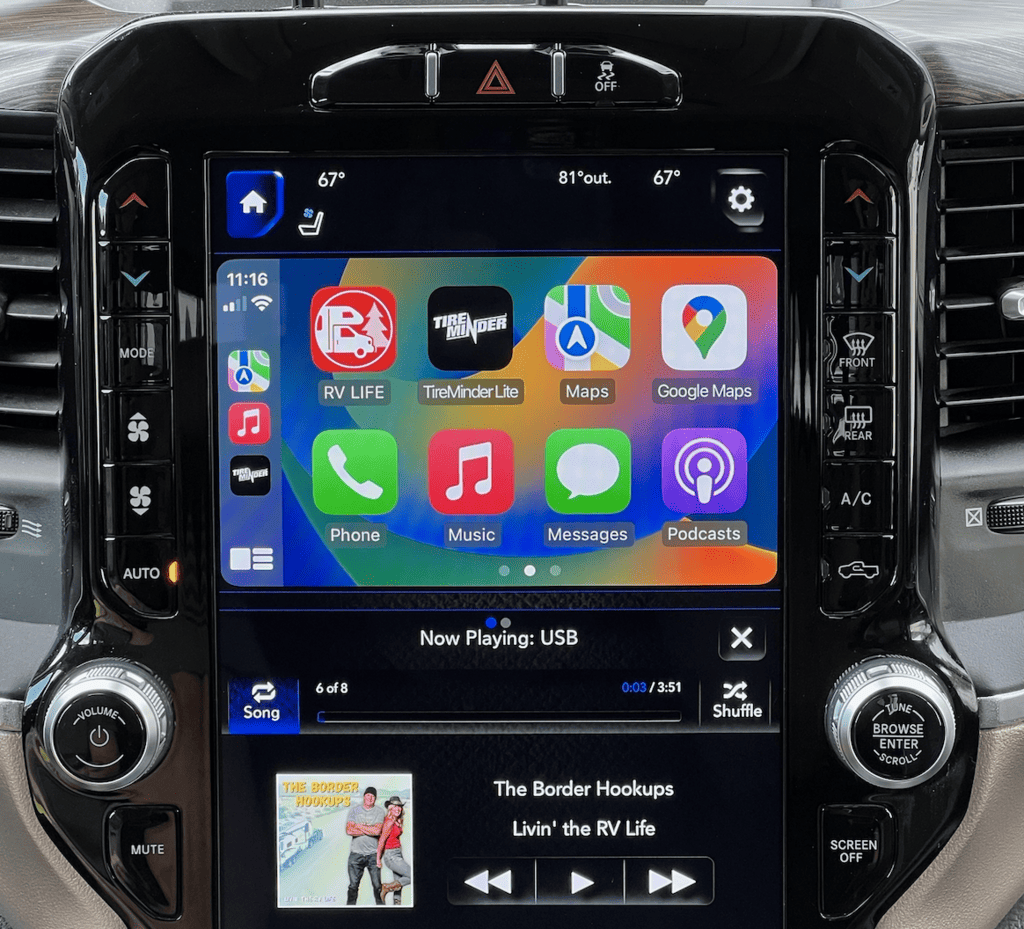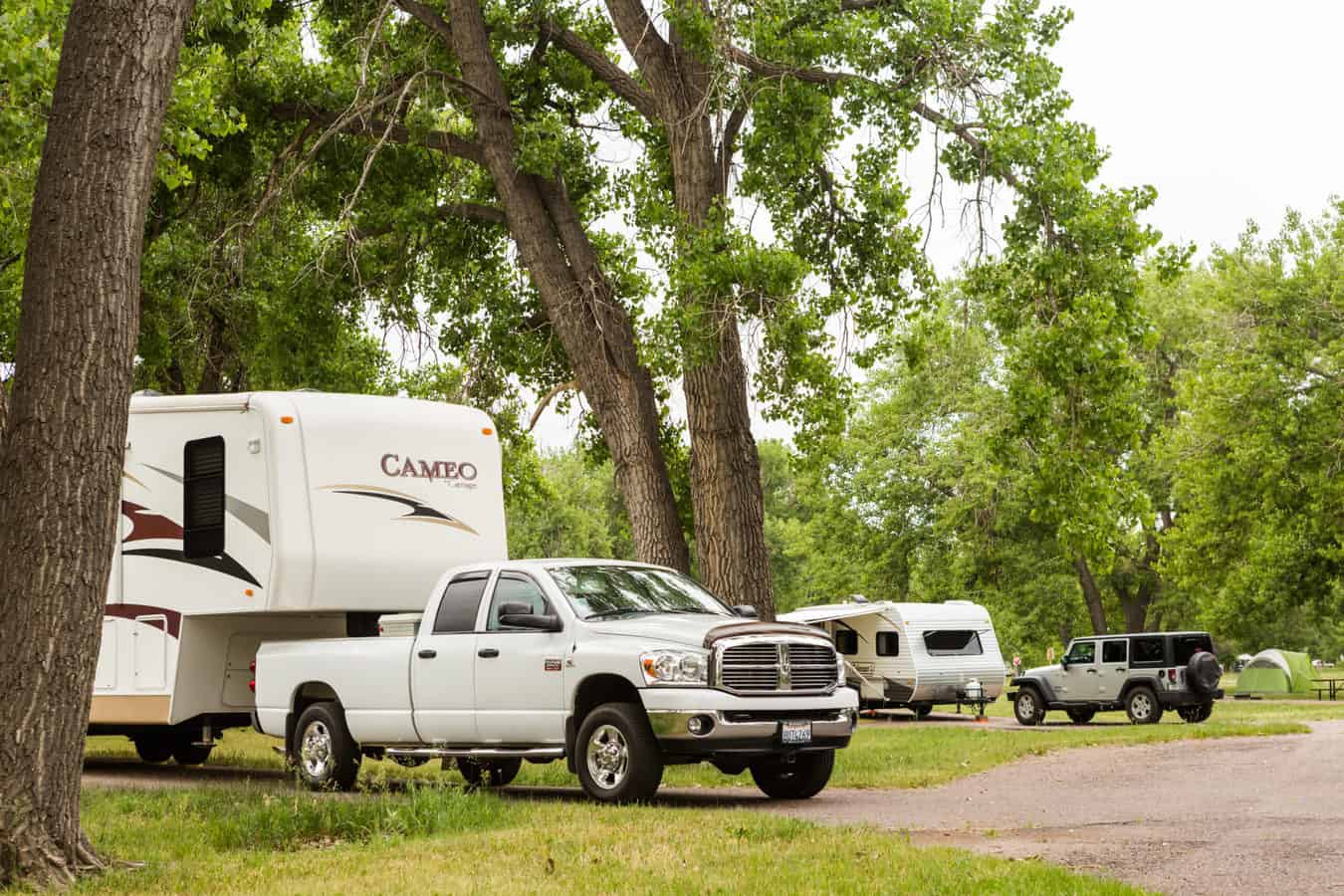
Whether you’re new to the world of travel trailers or have been using them for years, a common problem you’ll run into is sticky trailer hitches. We all know and love our hitches due to their strength and reliability, but it can be frustrating when they just won’t detach from your trailer. Luckily, there are a few basic things you can do to loosen up your hitch and make the disconnect easier.
To disconnect a travel trailer from its hitch, release the locking mechanisms and all safety pins. Next, slowly drive the tow vehicle back and forth to loosen the hitch. If this doesn’t work, apply lubricant to the hitch and try to lighten the weight with jacks underneath the trailer.
In most cases, this method should do the trick! Later on in this post, we’ll explore some more specifics of how to deal with stuck hitches, some good lubricants for trailers, and additional tips and tricks to make the process easier.
Basic Unhitching Process:
You’ve got the basic outline of how to unhitch your travel trailer above, but let’s go into a little more detail here.
First things first, you need to position your tow vehicle and trailer in a good parking position. Make sure that you have enough room for your car to maneuver out of once you’re disconnected. Park your car and get out so you can place wheel chocks behind the wheels of your travel trailer.
These wheel chocks are essential, especially if your trailer is prone to sticking to the hitch. They make sure that your trailer doesn’t slide or shift out of place while you’re working on disconnecting the hitch.
Once everything is stable and level, you’ll want to go to the hitch itself and disconnect any safety chains or weight distribution bars that you have attached. Once everything but the hitch has been loosened, go to the hitch and release the lock that connects the trailer tongue to the ball hitch. If there are any safety locks or pins, you’ll want to remove those as well.
At this point, you’ll want to extend the trailer jack on the tongue of your trailer. Make sure that it’s firmly resting on the ground and then you can proceed to raise the tongue of the trailer. Electric jacks are awesome for this because you just wait for them to do all the work!
Once the trailer has been raised far enough to take weight off of the ball hitch, you can turn off your jack.
Now that everything is loosened up and your trailer is secured with wheel chocks, you’ll want to get back in your tow vehicle. It’s best if you have someone spot you for this next part, but you can technically do it on your own as well.
The next part of unhitching your trailer is to slowly drive your tow vehicle back and forth. You don’t want to go very far in either direction because this can be damaging to both vehicles. Try to just move an inch at a time.
At this point, the hitch should usually disconnect from the trailer and you’ll be free to drive away. However, if you’re dealing with a sticky hitch, you may need to get out of your car and adjust the jacks a few more times.
Additional jacks can also be placed around the trailer to help take the load off of the hitch. These make it easier to slide over the ball hitch and disconnect smoothly. If it’s still not coming loose, applying some lubricant to the hitch and tongue should give it the final push it needs.
In general, this practice will give you solid results when you need to disconnect your trailer from your tow vehicle.
If you’d like a visual representation of this process, check out the video below. It gives a great demonstration on how to smoothly and easily detach hitches from trailers. Give it a look if you’re interested in learning more!
Removing your Hitch from the Receiver:
Another common problem concerning ball hitches for travel trailers is the connection they have to the hitch receiver in their respective tow vehicles.
Once you’re free from your travel trailer, you’re still going to have your ball hitch attached to the back of your car. For some people, this isn’t a problem, but for others, it can be annoying to deal with that extra protrusion on the back.
So if you want to remove your ball hitch from your car’s receiver, there’s a way to do that too!
First thing’s first, detach everything that might be adding weight onto the ball hitch. Obviously, this includes trailers, boats, or bike racks that might use the hitch.
Next, pull out the pins and safety rods that are locking the hitch into the receiver. You’re not going to be able to budge it if these are still in place!
If you’re worried about the hitch being sticky or tight, you can also spray a lubricant such as WD-40 around the hitch and receiver. If you do this, make sure that you apply a lot of it. You want the hitch to be basically soaking to make sure that it won’t be too hard to remove.
Now we get to the fun part. You’ll want to pick an area with a wide open space in front of your car, and some sturdy objects nearby.
Back your vehicle up and position it next to a strong, upright object. Many people like to use fields or lawns that are dotted with sturdy trees. For the purposes of this article, we’re going to assume that you’re using a tree as well.
Park your tow vehicle and find a decent length of strong metal chain. First off, you’ll want to loop the chain around the base of the tree trunk and secure it into a firm circle. Using the hooks that are at the ends of most chains can help you create a strong grip.
Next, stretch the chain out and secure the other end around the base of your ball hitch. Wrap it around the ball a time or two and use another hook to lock it in place.
Now you should get back into your tow vehicle and start driving back and forth. If your car has the option for 4-wheel drive, use this. It gives you better traction and you’ll make less of an impact on the ground.
Start by driving forward relatively slowly. You don’t want to floor the accelerator or you could end up doing serious damage to your bumper or flying forward faster than you expected. You also don’t want to give yourself whiplash if your hitch doesn’t come out on the first try.
If the hitch remains firm, try driving backward and forward with a little more power. Don’t go too crazy, but start to apply firm pressure and build up a little momentum. Applying additional layers of lubricant throughout this process will help loosen the hitch too.
After a few tries, your hitch should pop free from the receiver. Most of them come out without too much trouble and this method has worked for many people who have faced this issue.
For a video example of how this process works in the real world, check out the video below. Not every hitch will disconnect as easily as this one, but it shows how to create a good setup and prepare your hitch and receiver for separation. Check it out!
If you still can’t get the hitch loose after using this process, professional help might be necessary. Don’t endanger your car, property, or trees by pushing the limits too far!
Good Trailer Hitch Lubricants:
I know I’ve mentioned using lubricants a few times already in this post, but I haven’t given you some good recommendations for the job. Well, worry no longer! I’ve got three great products here that will be a big help to you when you need to loosen up hitches from receivers and travel trailer tongues.
Each one of them are highly rated and pretty cheap. I can highly recommend any of them!
WD-40 490026 Multi-Use Product with Smart Straw
- Price: $3-$5
- Rating: 4.7/5
WD-40 has been a staple of the automotive and home maintenance world for a long time. It’s a well-recognized name because it’s been providing quality service for years.
WD-40 is a lubricant that is stored in small aerosol dispersal cans. Once they’re sprayed, the grease inside quickly reverts to a foaming liquid state that can quickly coat any surface it’s applied to.
It’s also great for dissolving rust and adhesive substances. This makes it perfect for sticky situations like a ball hitch that won’t disconnect from a trailer or hitch receiver.
A basic can of WD-40 contains 8 ounces. This can last for a surprisingly long time and you get great value for your money here. It’s also easy to purchase bulk packs of WD-40 that contain up to 12 cans.
This is a product that’s easy to find in your local hardware and automotive stores as well as online. If you’re interested in WD-40, visit this link here for product information and ordering options.
Reese Towpower 58117 Hitch Ball Lube
- Price: $10-$15
- Rating: 4.5/5
The Reese Towpower lubricant is another great option for travel trailer owners. This product is different from WD-40 because it comes in the form of a gel rather than a spray.
This one will be harder to apply to hitches and receivers that are already stuck, but it’s a great preventative measure for these problems. Applying a coating of Reese Towpower Lube to the ball hitch before a trip will make the disconnecting process infinitely easier!
You can apply this product with your hands, a brush, or a small rag. Whichever method works best for you!
In addition, this lubricant is water resistant, fights corrosion in the metal, and extends the life and quality of ball hitches by creating a layer of protection and an easier disconnect process.
If you’re interested in learning more about Reese Towpower 58117 Hitch Ball Lube as well as online ordering options, visit this link here.
Permatex 80345 White Lithium Grease
- Price: $3-$5
- Rating: 4.7/5
This lubricant is great and easy to use the product. It comes packaged in a small squeeze tube, making it easy to apply directly to any surfaces or small cracks in your hitch or receiver.
This is great for people who like to keep their hands clean! While the last product required you to spread the lubricant around the surface, this one has a small pointed nozzle that enables you to squeeze it out without needing to touch it directly.
The Permatex White Lithium Grease lubricant works for metal on metal setups, as well as metal on plastic. This makes it adaptable to a variety of needs. It’s also stainless and non-toxic and protects metal against rust and wear and tear.
Permatex is also resistant to moisture and high heat. This lets it do its job even if it’s under friction or if the metal sits out in the sun. The moisture protection is another way that it prevents rust as well. Overall this is a great lubricant that can be used for a variety of automotive and home maintenance jobs.
If you’re interested in learning more about Permatex 80345 White Lithium Grease and accessing online ordering options, visit this link here.
Why Trailer Hitches Get Stuck in the First Place:

Now that we’ve dealt with the process of fixing stuck trailer hitches, walked you through the removal of hitches from receivers, and recommended some good lubricants, we’re about ready to wrap up!
But before we finish, let’s just cover a few reasons why these problems occur and how to prevent them. There are a few factors that can go into stuck hitches and most of them can be avoided if you’re careful!
Incorrectly Sized Equipment
One of the biggest factors that will cause you problems with your ball hitch and trailer tongue is choosing the incorrect size of the receiver and ball.
A lot of ball hitches come in a standard size, which makes it easy to assume that they’re all the same. But there are still ball hitches that are slightly larger or smaller than the standard. Always make sure to match the measurements of your hitch to your receiver.
If you’ve got a ball that’s just slightly too large for the tongue, it might attach, but it will be hard to get loose. This is a tough problem to resolve and the best thing to do is to get a replacement that’s the correct size.
Rust
Rust is one of the biggest culprits of stuck trailer equipment. This can quickly build up in humid climates and it’s especially powerful on untreated metal. A lot of hitches and trailer equipment comes with special coatings that prevent rusting, but this can rub off over time.
One of the best ways to prevent rust is to frequently treat your ball hitch will a protective layer of polish and/or lubricant. Many of these are water resistant and keep rust from forming.
Cold
Cold is another factor that can make disconnecting difficult. When it’s below freezing outside, metal can contract and shrink. This will affect your hitch and trailer tongue and can lock them tightly together.
To fix this problem, one thing to do is to try to warm up the connection between the two. Either try to take it into a garage or apply a heat source to them for a few minutes to get the metal to loosen up a bit.
Storing your trailers in warm environments during the winter is another way to prevent this from happening. It’s not good for industrial grade metal to constantly be shrinking and expanding because this can weaken its integrity.




I just picked up my Cruiser RV Hitch 16 RD. I am using a Husky Weight Distribution Hitch. I had problems with the ball releasing from the Hitch. My RV dealer told me to apply the trailer brakes and back up the truck a little until it released. It did release. When I got out of the truck and it rolled forward a bit it got stuck again. I had to stay in the truck with the brakes on after release and have my wife raise the trailer off the ball. My dealer says this is normal? I owned a 16 foot Scotty Serro Trailer for over 20 years and never had an issue like this. I would appreciate any help or comments. Thank you.
Nice article : just curious about freeing up a rusted receiver mechanism that is permanently attached to the 50 year old house trailer in the woods so it will open/turn to receive a ball & hopefully not lock up & stick on the ball, as this article talks about as we’ve also had to use Sea Foam Deep Creep to get the Crank Assembly freed up as well … thx
What is a house trailer? Do you mean mobile home or travel trailer ?
Very confusing question. Might be able to help with more specific information.